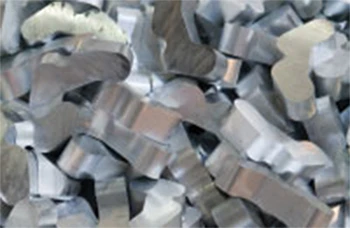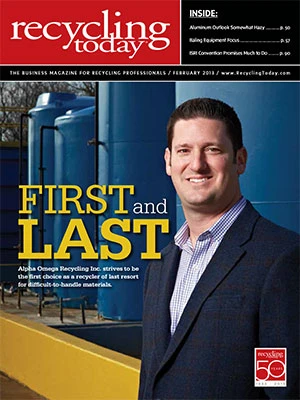
 When the aluminum producer Alcoa, headquartered in Pittsburgh, was optimistic during the presentation of its 2012 fourth quarter earnings report in early January, Wall Street rallied. As the company sells to a diverse range of industries, this bullishness indicated improved end markets for industries such as aerospace, transportation, housing and packaging.
When the aluminum producer Alcoa, headquartered in Pittsburgh, was optimistic during the presentation of its 2012 fourth quarter earnings report in early January, Wall Street rallied. As the company sells to a diverse range of industries, this bullishness indicated improved end markets for industries such as aerospace, transportation, housing and packaging.
Alcoa forecasts that global aluminum demand will grow by 7 percent in 2013, a slight increase from 2012’s 6 percent increase.
In discussing the company’s outlook for 2013, Klaus Kleinfeld, Alcoa chairman and CEO, said he expected to see global growth throughout Alcoa’s key sectors in 2013, with aerospace leading the way with 9 to 10 percent growth. He also predicted 1 to 4 percent growth in automotive production; 2 to 7 percent growth in the heavy truck and trailer sector; 2 to 3 percent growth in beverage can packaging; 4 to 5 percent growth in commercial building and construction; and 3 to 5 percent growth in industrial gas turbines.
This projected growth will be driven primarily by China. In fact, according to Alcoa’s presentation, growth prospects for aluminum in Europe are limited to the packaging sector. Additionally, the transportation and building and construction sectors are forecast to decline in Europe in 2013.
On a brighter note, aluminum is making inroads in replacing copper in a variety of applications, including HVAC, consumer electronics and building facades, according to Alcoa. This diversity has created optimism for aluminum markets in the longer term.
Contributing to aluminum’s long-term growth in the transportation sector will be the push to lighten automobiles to improve fuel efficiency. For instance, Land Rover recently introduced the world’s first all-aluminum SUV, the 2013 Range Rover. Additionally, Ford Motor Co. is testing a F-150 pickup truck, which it expects to launch by the middle of this decade. The model features body panels made from aluminum rather than from steel. According to an article in the Wall Street Journal, this move will lessen the vehicle’s weight by 700 pounds.
Overall, the consulting firm Ducker Worldwide says cars will contain twice the amount of aluminum, which will amount to 16 percent of the vehicle by weight, by 2025. The increased use of aluminum is expected to reduce overall vehicle weight by 400 pounds, according to Ducker Worldwide.
Not so Fast
Despite this bright longer-term outlook, a number of challenges currently dull its present outlook. An imbalance in supply and demand continues to be one of the biggest drags on aluminum in the near term. An estimated 1.3 million metric tons of capacity have been removed from the market in the past year. Despite these significant global capacity cuts by many of the largest aluminum producers, a sizable overhang of aluminum production capacity remains, acting like a brake on the market.
 New aluminum production capacity was built to capitalize on the growth seen in the housing market during the beginning of this century. However, the subsequent collapse of that market has forced many of the largest aluminum producers to slash production.
New aluminum production capacity was built to capitalize on the growth seen in the housing market during the beginning of this century. However, the subsequent collapse of that market has forced many of the largest aluminum producers to slash production.
During the peak of the housing bubble in 2007, the Australian firm Rio Tinto acquired Canada-based aluminum producer Alcan for roughly $38 billion. Since then, Rio Tinto has been struggling with excess capacity and has been cutting aluminum production in response.
Despite these cuts, Rio Tinto has written down $18.2 billion—nearly half of Alcan’s $38 billion purchase price—since it bought the company. The company says it purchased Alcan at the peak of the market and overpaid for the business.
Bank of America (BoA) Merrill Lynch recently released a report that touches on the global challenges to the aluminum industry. The company estimates that up to 25 percent of the world’s aluminum smelters are unprofitably producing aluminum. “Steady or rising alumina prices on the back of resource nationalism could force much needed aluminum production cutbacks, especially for those smelters that are not vertically integrated,” the BoA Merrill Lynch report states.
A Little Excessive
High inventories of finished aluminum have contributed heavily to the suppression of the aluminum market.
Charles Bradford, a metals analyst with the research firm Bradford Research Group, New York City, says roughly 5 million metric tons of aluminum are inventoried at London Metal Exchange (LME) warehouses, which indicates far more aluminum has been produced than necessary. This is a record level of aluminum in inventory, Bradford says, and with few signs of a robust return in many consuming sectors, he says he feels inventories will be at near-record highs for the foreseeable future.
Low interest rates contribute to the sizable amount of aluminum presently being warehoused. According to one source, financial institutions are purchasing, warehousing and selling aluminum to the futures market. As a result, the metal is being kept out of inventory and being used as a profit center rather than going to consumers, the source says.
A report released by CitiGroup in late 2012 asserts that financial firms hold between 65 and 75 percent of the aluminum stored in LME warehouses.
According to Alcoa, as much as 90 percent of the aluminum inventory that’s traded simply moves around as financed inventory instead of going to customers. “As long as financing is cheap and the forward curve remains steep, it’s unlikely that we’ll see this inventory actually become marketable. This trend will keep volatility high for the foreseeable future,” Matt DiLallo writes in a Jan. 10, 2013, article for the Motley Fool, www.fool.com, that looks at the aluminum outlook for 2013.
Mike Gildea, CEO of Kalamazoo, Mich.-based Schupan Aluminum & Plastics Sales, says the growing presence of financial institutions in the aluminum market continues to have a negative effect on the global aluminum market.
These investing outlets have created an uncertain market for companies that physically handle the metal, whether as scrap or as the finished product.
“Commodities are not based on supply and demand any more,” Gildea says.
While aluminum production and inventories have risen, improved demand has kept this overcapacity from having an overly negative effect on aluminum prices, according to CitiGroup report.
Financial Effects
Bradford says that Europe, a key consuming destination for aluminum, will continue to present problems in terms of demand. He speculates that it will be five years before the continent “gets its act together.” However, aluminum producers in Europe will resist cutting too much capacity and reducing employee ranks, he adds.
High electricity costs throughout much of Europe will further hobble that region’s aluminum producers.
 The United States, while experiencing a tepid economic recovery, is contending with significant fiscal problems at the federal level. Therefore, the short-term outlook for aluminum during the first half of 2013 is muted.
The United States, while experiencing a tepid economic recovery, is contending with significant fiscal problems at the federal level. Therefore, the short-term outlook for aluminum during the first half of 2013 is muted.
Aluminum consumption should grow by a modest 1.3 percent in 2013, according to CitiGroup. The tepid growth is attributed to slower economic growth in China and to continued problems with Europe’s sovereign debt crisis.
While economic conditions in Europe and North America will be watched closely, the key factor will be China. In its most recent figures, the International Aluminium Institute, London, reports that China is responsible for close to half of all the aluminum produced in the world. While several economists are forecasting a slower Chinese economy in 2013, other see cause for optimism. The new Chinese government has announced plans to invest $150 billion in infrastructure projects in the country. The investment could significantly boost demand for a range of metals, including aluminum, they say.
Supporting a cautious shorter-term outlook is Svein Richard Brandtzæg, president and CEO of the Norway-based aluminum producer Hydro. In a presentation he gave during the company’s Capital Markets Days 2012, which was held Nov. 29-30 at the company’s Oslo headquarters, Brandtzæg said the current high levels of macroeconomic uncertainty and a multi-speed world economy were weighing on consumer sentiment, which in turn has led to weaker aluminum prices and to softer end markets for the metal.
Brandtzæg said global aluminum demand outside of China would grow from 2 to 4 percent in 2013. Aluminum fundamentals remain promising because of the metal’s many positive qualities, including its light weight and recyclability, he said. Brandtzæg predicted that the global aluminum market would show solid long-term growth of 4 to 6 percent per year during the next 10 years.
“Although aluminium has seen the fastest-growing demand among base metals, we have also seen strong growth in new capacity, resulting in low prices and inadequate returns,” Brandtzæg added.
The author is senior editor of Recycling Today and can be contacted via email at dsandoval@gie.net.

Explore the February 2013 Issue
Check out more from this issue and find your next story to read.
Latest from Recycling Today
- BMW Group, Encory launch 'direct recycling’ of batteries
- Loom Carbon, RTI International partner to scale textile recycling technology
- Goodwill Industries of West Michigan, American Glass Mosaics partner to divert glass from landfill
- CARI forms federal advocacy partnership
- Monthly packaging papers shipments down in November
- STEEL Act aims to enhance trade enforcement to prevent dumping of steel in the US
- San Francisco schools introduce compostable lunch trays
- Aduro graduates from Shell GameChanger program





